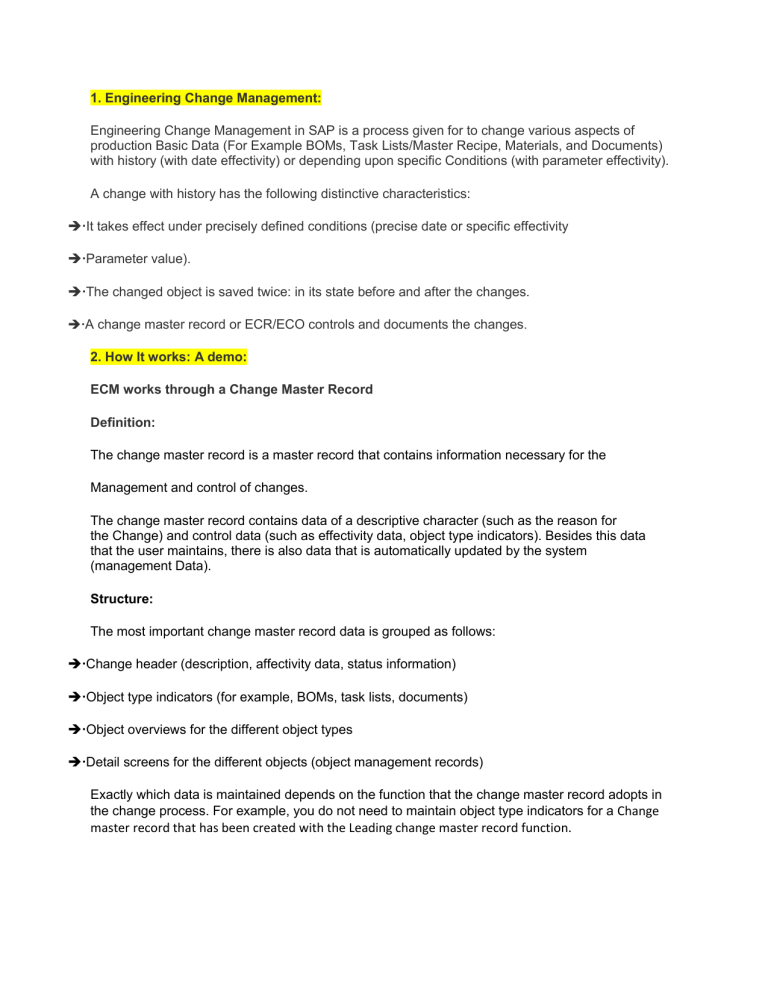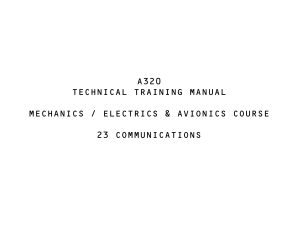
1. Engineering Change Management: Engineering Change Management in SAP is a process given for to change various aspects of production Basic Data (For Example BOMs, Task Lists/Master Recipe, Materials, and Documents) with history (with date effectivity) or depending upon specific Conditions (with parameter effectivity). A change with history has the following distinctive characteristics: It takes effect under precisely defined conditions (precise date or specific effectivity Parameter value). The changed object is saved twice: in its state before and after the changes. A change master record or ECR/ECO controls and documents the changes. 2. How It works: A demo: ECM works through a Change Master Record Definition: The change master record is a master record that contains information necessary for the Management and control of changes. The change master record contains data of a descriptive character (such as the reason for the Change) and control data (such as effectivity data, object type indicators). Besides this data that the user maintains, there is also data that is automatically updated by the system (management Data). Structure: The most important change master record data is grouped as follows: Change header (description, affectivity data, status information) Object type indicators (for example, BOMs, task lists, documents) Object overviews for the different object types Detail screens for the different objects (object management records) Exactly which data is maintained depends on the function that the change master record adopts in the change process. For example, you do not need to maintain object type indicators for a Change master record that has been created with the Leading change master record function. Integration In the R/3 System, change master records are identified by a change number. is made according to defined criteria. In the change process, a change number can identify change master records with the following tasks: Simple change master record (with or without release procedure) ECR / ECO Change master record of an engineering change hierarchy Change leader (Leading change master record) A sample Change Master Record Creation: Use the Transaction Code CC01. When Save Assigning the Change Master Record to the Material Master during a New Material Creation For Creating the Material Master Use the Transaction Code MM01 and here assign the change number Once saving the material the material will get created with the change number. Soon after getting the material this material can be changed with the change number assigned or can be scheduled for change at a later stage. All the changes will get saved for display to have the change history of the record. 3 Material Master Control through ECM A Material Master which had been created with a Change Control Record or a material Master which has been changed with a Change Control Record can have many usages when compared with a material master which is crated or changed without a change control record. For Example Control of the Master Data: Master Data like Material Master serves as a central data for various applications like External and Internal Purchasing documents , BOMs, Scheduling , Sale Orders etc and hence the changes which are being planned or which are being changed needed to get documented. This Documented data will serves in controlling the change. The material data like Valuation Class, Profit Center, Tax Classifications, Classification data, etc are termed to be most important and the change to the values leads to application to run erratically. And hence the change Records will provide provision for controlled change of the material master. Change records authorization will provide a controlled atmosphere for the changes Material master though it contains the changes record will just serve as just a Data , but when created or changed through Change Master Record will contain the history of the changes for Past and present , and can give a way to plan for the flow of the changes for present and for future. Once the materials are created or changed through change control records, automatically in a course of time the duplicity will get reduced. Revision Level : Through the Change Number Assignment concept for the material master we can have the Revision level for the change . A Brief Demo for the same . AT CC11 screen Once Press Enter Once Press Enter Once save the record , Revision level gets assigned to the material. 4.How the Process helps in controlling losses: The below Examples will depict how a loss can be raised: An unwanted change in the material master for a valuation class can lead to configuration issue for a GL account, thereby loosing time in a goods Receipt entry which in turn might cause a shortage leading to production down time or a late goods issue for the delivery might cause a customer loss. An unwanted or un authorized change in the Profit center can cause a Controlling and Profitability (COPA) issue. An unwanted change in UOM can cause an issue everywhere of the all the applications To name these are few are the losses created by an unwanted change for the master data like material master. Through controlled changes of the master using the ECM can improve the margins in a phased manner. 5. Conclusion Though Engineering Change Management applies to many areas, Material Master is one such, which needed to get controlled for the changes as the change applies to many areas of application .The Controlled change through ECM leads to proper documentation of the changes and provides a controlled environment for the changes.




